An Article from PubMed
Central-NIH National
Library of Medicine on Targeted
treatment of cancer with radiofrequency electromagnetic
fields
amplitude-modulated at tumor-specific
frequencies

In 2001, Barbault et al.[20] hypothesized that the growth
of human tumors may be sensitive to specific modulation
frequencies. To test this hypothesis, they initiated
a patient-based research
using novel biofeedback devices and techniques, which
led to the discovery that patients with the same tumor
type
had biofeedback responses to the same frequencies, irrespective
of their sex, age, or ethnic status[20]. Frequencies
identified in patients with cancer were predominantly found
above
1,000
Hz. This range is significantly higher than the range
within which insomnia frequencies had been identified (<300
Hz). They also discovered that, in contrast to what had
been observed
in patients with insomnia, biofeedback responses were
only observed at very precise frequencies. This prompted
the
development of highly precise frequency synthesizers
for the detection
of tumor-specific frequencies. Interestingly, the majority
of frequencies identified in a given tumor type was only
found in patients with the same tumor type[20]. For example,
85% of the frequencies identified in patients with HCC
were only found in other patients with HCC. Similarly,
75% of
the frequencies identified in patients with breast cancer
were only found in patients with the same tumor type[20].
They also discovered that a small number of frequencies,
e.g., 1,873.477 Hz, 2,221.323 Hz, 6,350.333 Hz, and 10,456.383
Hz, were found in the majority of patients with breast
cancer, HCC, prostate cancer, and pancreatic cancer[20].
Examination
of healthy individuals without a diagnosis of cancer
did not reveal any biofeedback responses to the frequencies
identified in patients with a diagnosis of cancer.
Then
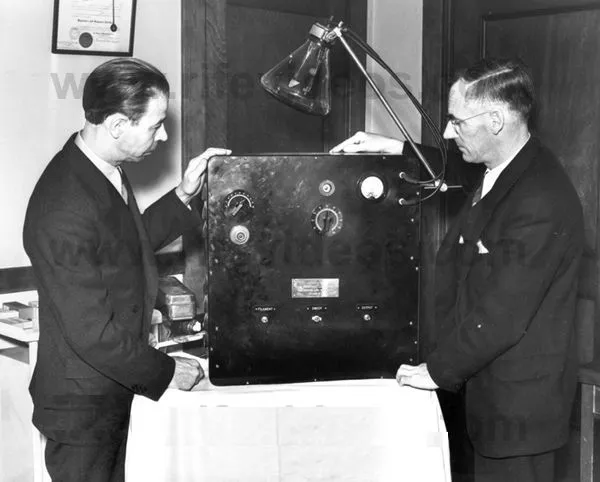
Royal Rife and Phillip
Hoyland acknowledged
all frequencies in their sweep function
Now
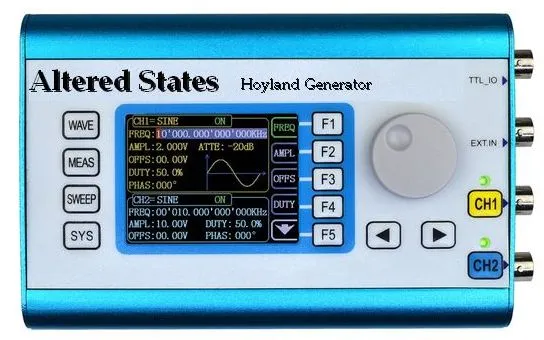
Clinical Experience with Intrabuccal Administration of
Amplitude-modulated Radiofrequency Electromagnetic Fields
After having successfully identified tumor-specific frequencies
in 163 patients with cancer, Barbault et al.[20] offered
compassionate treatment to 28 of these patients with
advanced cancer and limited therapeutic options. Treatment
was administered
with a portable device built with the same high precision
frequency synthesizer as that used for the identification
of tumor-specific frequencies. They chose the 27.12
MHz carrier frequency, as it is universally approved for
medical use.
The 27.12 MHz signal was amplitude-modulated at the
specific
frequencies identified in patients diagnosed with cancer.
The frequencies were emitted sequentially, each for
3 s from the lowest to the highest frequency, and the cycle
was continuously
repeated for 1 h. Treatment was administered 3 times
a day, i.e., for a total of 3 h until disease progression
or death.
Intrabuccal administration of 27.12 MHz RF EMF with
the
TheraBionic device results in a whole body absorption
of very low levels
of EMF (Figure 2). The maximum specific absorption
rate of the applied RF averaged over any 10 g of tissue
is
estimated
to be less than 2 W per kg[21].

The results of this study, with a cutoff date of
April 1, 2009, are published[20]. Briefly, 1 patient
with
biopsy-proven stage IV breast cancer metastasized
to the left femur
and
right adrenal gland had a complete response lasting
11 months. One patient with biopsy-proven stage
IV breast
cancer metastasized
to the liver and skeleton had a partial response
lasting 13.5 months. Additionally, 5 patients had
stable disease
for +34.1 months (thyroid cancer with biopsy-proven
lung metastases), 6.0 months (mesothelioma metastasized
to
the abdomen), 5.1 months (nonsmall cell lung cancer),
and 4.1
months (pancreatic cancer with biopsy-proven liver
metastases). Two patients were still undergoing
treatment as of April
1, 2009. One patient with ovarian cancer refractory
to cisplatin and taxanes underwent treatment for
2 additional
years for
a total of 73 months. She had disease progression
and died 78 months after enrolling in the study.
The patient
with
stage IV thyroid cancer metastasized to the lungs
remains on treatment as October 1, 2013 (Figure
3), and has
received continuous treatment for a total of 86
months.
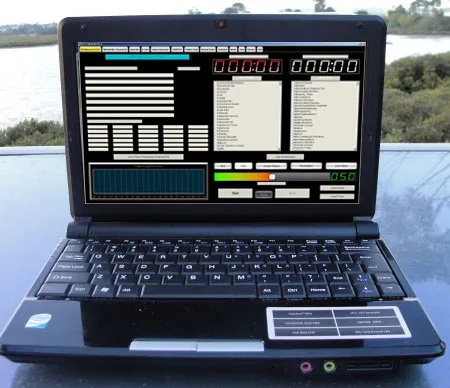
Clinical improvement has been observed within a
few weeks of treatment initiation. Two patients
with
painful breast
cancer bone metastases experienced significant
symptomatic improvement within 2 weeks[20]. Similarly,
among
11 patients with advanced HCC and pain prior
to treatment initiation,
5 reported complete disappearance and 2 reported
significant
alleviation of pain within a few weeks of treatment
initiation[21]
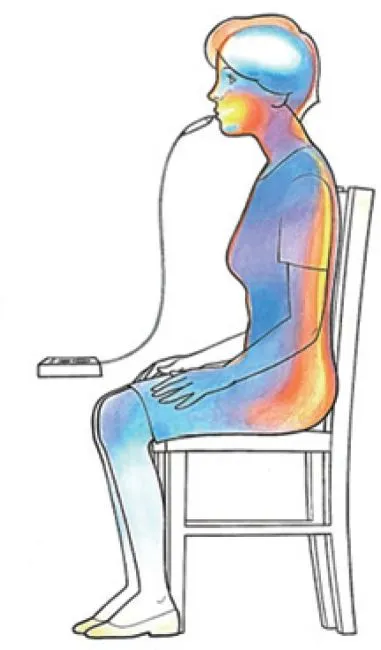
Figure 2.
Delivery of intrabuccal radiofrequency (RF) electromagnetic
fields (EMF).
Patient receives low levels of EMF that are minimally
absorbed and distributed systemically with the body acting
as an antenna. Yellow indicates the regions of the body
receiving the greatest exposure.
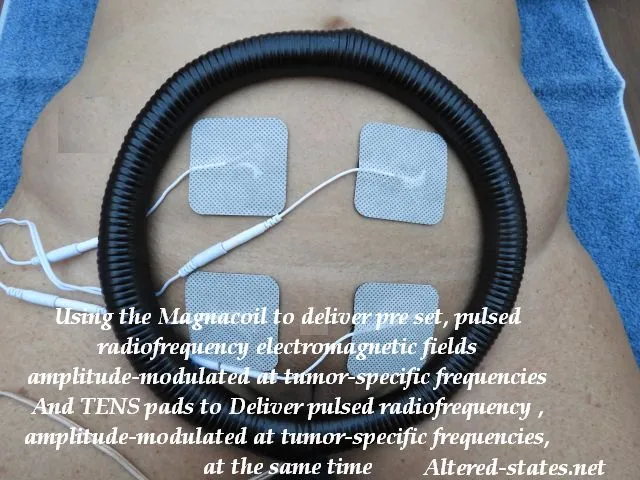
Using the Magnacoil to deliver pre set,
pulsed radiofrequency electromagnetic fields amplitude-modulated
at tumor-specific frequencies
And TENS pads to Deliver pulsed radiofrequency , amplitude-modulated
at tumor-specific frequencies, at the same time
Conclusions
In summary, our clinical results provide strong evidence
that the intrabuccal administration of RF EMF amplitude-modulated
at tumor-specific frequencies is safe and well-tolerated
and may lead to long lasting therapeutic responses in patients
with advanced cancer. Our in vitro experiments demonstrate
that cancer cell proliferation can be targeted using tumor-specific
modulation frequencies, which were identified in patients
diagnosed with cancer. Tumor-specific modulation frequencies
block the growth of cancer cells, modify gene expression,
and disrupt the mitotic spindle (Figure 6). Studies are
underway to dissect the biophysical mechanism leading cancer
cells to respond to specific modulation frequencies identified
in patients with a corresponding diagnosis of cancer but
not to randomly selected or tumor-specific frequencies
identified in other tum
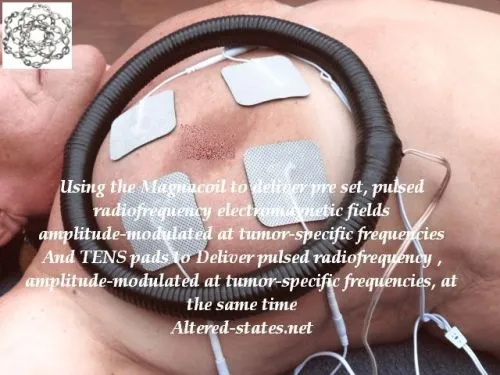
Using
the Magnacoil to deliver pre set, pulsed radiofrequency
electromagnetic fields amplitude-modulated
at tumor-specific frequencies .And TENS pads to Deliver
pulsed radiofrequency , amplitude-modulated at tumor-specific
frequencies, All at the same time Many thanks to the clients who donated their pictures
The Rife 2H- 4H Systems below has a frequency
"set", that includes all the above frequencies pre
programed, and
uses "electromagnetic fields amplitude-modulated
at tumor-specific frequencies" or if required intrabuccal
administration of RF EMF frequencies...
If you Already have one of our Rife 2h-4h Systems
this set of frequencies is listed on the hoyland software,
under "tumors". The
article suggest one runs these frequencies 3 times
a day..
Please
help, share this Newsletter to family and friends.
|

